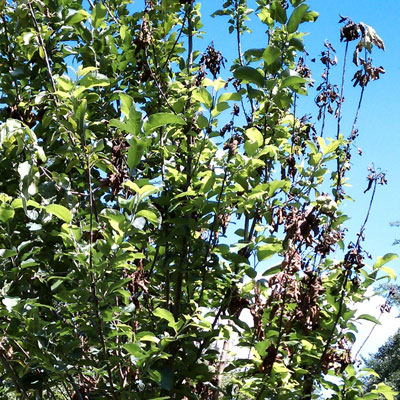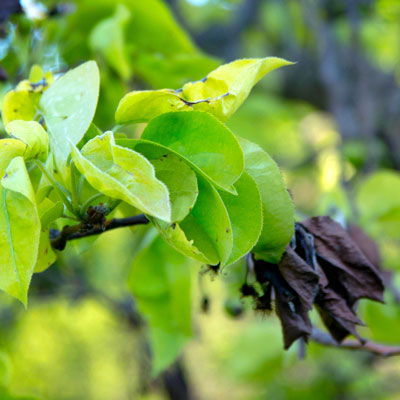Question of the Week – Number One: April 30, 2020
“What is happening to my apple tree?”
It has been hit by the bacterial disease known appropriately as fire blight. There are some peculiar things you need to know about this disease.
Facts to remember about fire blight…
• It’s bacterial, not fungal. Caused by Erwinia amylovora.
• It attacks only members of the Rose family of plants. Most prone include apples, pears, loquats, pyracanthas, cotoneasters, photinias (redtips). Does not impact roses, peaches or plums.

• Bartlett pears and other highest-quality eating pears are of the highest susceptibility and should never be sold in Texas.
• Even Bradford and other ornamental pears have begun to show great susceptibility in recent years.

• Causes tips of branches to die suddenly, turn black and shrivel.
• Dead twigs are usually 6-15 inches long at the ends of the branches. They remain attached to the trees and shrubs and serve as sources of inoculation for future outbreaks.
• The disease can kill highly susceptible plants in a matter of months or a few years.
Dealing with fire blight…
• Start with resistant varieties. In the case of pears, your best options are Orient, Kieffer, Garber and Douglas. You don’t see as much written about comparative fire blight resistance of apple varieties here in Texas, but here is a compilation from Extension specialists from many states.
• Avoid heavy pruning and applications of high-nitrogen fertilizers. Both of these promote vigorous new growth, and such shoots are much more susceptible to the disease.
• Texas A&M no longer recommends application of streptomycin, saying that good cultural practices are the best means of dealing with the disease.
• Prune out dead twigs, cutting the dead branches 6 to 8 inches below the interface with live tissue.
• Disinfect pruning tools between each cut by dipping in a bucket of 10 percent chlorine bleach and 90 percent water. When finished, rinse in water and oil.
• Keep fallen leaves and other debris picked up off the ground immediately each fall.
There are many good university publications on fire blight, several from Texas A&M. Here is one general one.
